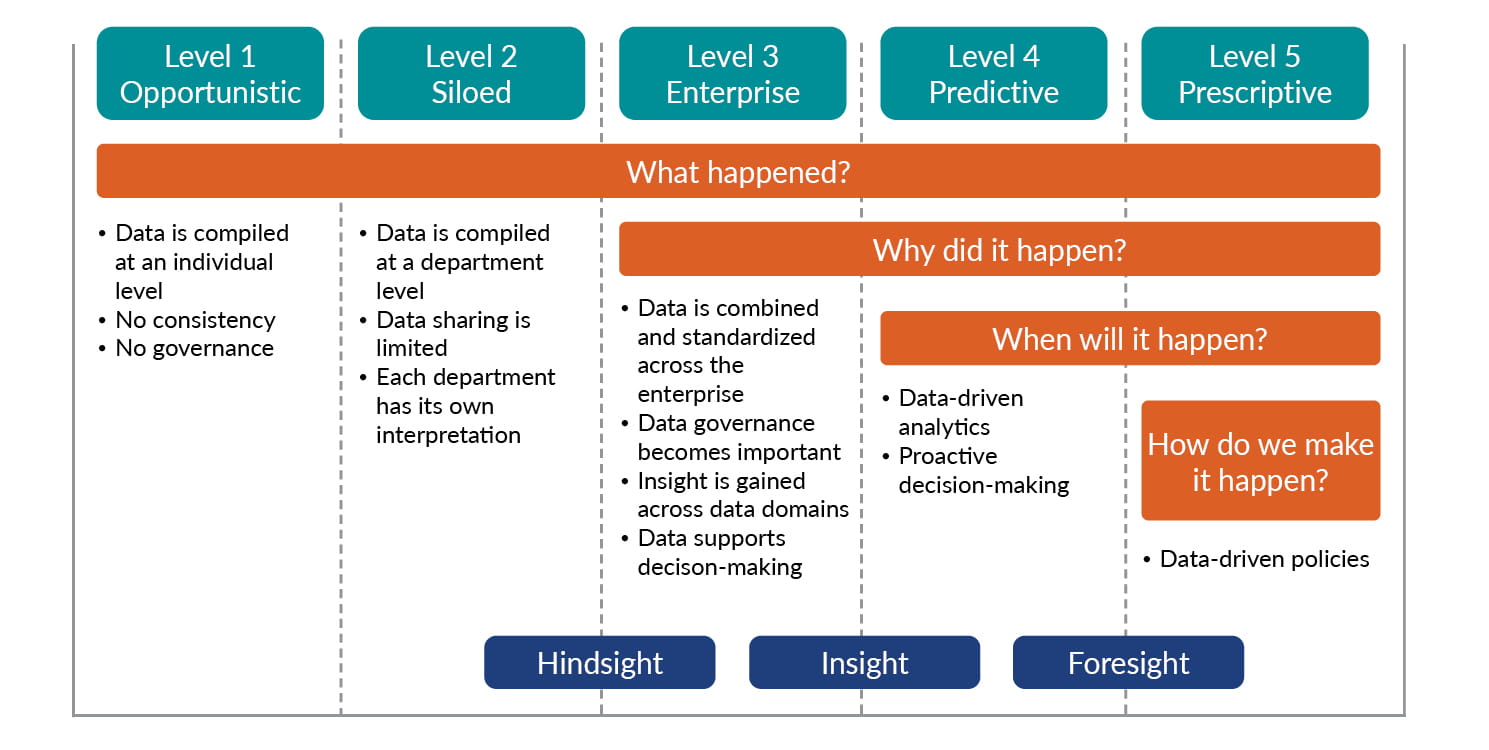People intuitively use the lessons of the past to make better decisions for the future. We call it experience, and we gain it by observing what’s happened and then identifying how best to control outcomes. But as organizations grow and become more complex, and the wealth of data produced on a daily basis expands exponentially, it’s not so easy to keep the same insights and intuitions. In order to make better business decisions in the “age of information,” you need a better way to leverage the data available to support better fact-based decision making.
Data analytics is the next competitive breakthrough following business automation, heralding increases in efficiency and effectiveness. But what if the data that feeds those analytics isn’t correct? The risk of making the wrong decision based off bad or unmanaged information may be as high, or higher, than the risk of making a decision based on experience alone. Many analytics programs are implemented without an understanding of this journey or the maturity that’s necessary to succeed. Where are you and your organization on the data journey, and do you have a complete understanding of the risks and rewards at each step?

Data analytics level 1: Opportunistic
Often the first push into analytics, this level is driven by necessity and facilitated by creative or frustrated individuals looking to fill a gap in describing and understanding business performance. Output may be visualized through a reporting tool, but is equally as likely to be in Excel. At this level there is very little quality control — data is often manually keyed or updated, can be very labor intensive, is prone to error, and often stored on an individual’s desktop. Output is often static in nature and distribution is limited — shared via email or posted to a server location. Reports generated by different people can often be contradictory based on different data sources, interpretations, and errors, and can be difficult to reproduce. Maturity level is low, but reports are often embraced enthusiastically merely for the new perspective they present.
While investment at this level is fairly low — indeed, it is almost organic — the level of control is almost non-existent and the risk of conflicting or misleading information is high. If you find yourself in this situation, take an inventory of all the solo projects that exist, and identify consistent requirements across each. This will allow your organization to define and quantify the latent demand for analytics and initiate development of a more uniform approach to investment and outputs.
Data analytics level 2: Siloed
This level is characterized by analytics initiatives that are aligned with and segregated by individual departments. Company-wide analytics investments are numerous, but approaches, capacity, capabilities and toolsets vary across the organization. While each department has their own piece of the puzzle, they never get the big picture because they’re not sharing with other areas of the business. While reporting is often more advanced, typically because of formal investment of department level resources, maturity and use of best practices is low to medium, and widespread adoption is limited by the segregation of information and lack of knowledge sharing.
Investment at this level is moderate, but can also be wasteful, given duplication of effort. Investments also may be repeated given the initial narrow scope with which those decisions are made. To take this to the next level, collaboration and strategy discussions should include representatives from all departments investing in analytics and should focus on development of:
- An analytics vision, success criteria, roadmap, and gap assessment.
- The creation of “art of the possible” visualization scenarios.
- Identification of key standards and business rules.
- Evaluation of tools and resources able to integrate and convey information quickly and effectively.
Data analytics level 3: Enterprise
This level is usually driven by executives with visions of a data-driven organization. While some reporting is still targeted toward individual departments, there’s an intentional effort to share information across the organization, where the combination of data elements can give executives more valuable insights and a more accurate picture of performance and operational health. Security becomes important as data is shared, and data governance starts to evolve as centralized reporting repositories are built. Data must be cleansed, standardized, mastered and architected to enable analytics discovery. Process and collaboration become especially important here.
It’s easy for enterprise-level project investments and scope to quickly escalate, so prioritization and focus is important. You won’t conquer the world in a day and phasing is an effective and common approach. Training, data management, and data governance are critical in establishing the foundation for a scalable analytics environment and frequent, manageable delivery targets (usually reports or dashboards), and increase adoption and ROI.
Data analytics levels 4 and 5: Predictive and prescriptive
Building on the foundation of the enterprise level, data is leveraged in more advanced combinations, often allowing users to run through multiple “what-if” scenarios. Statistical modeling, forecasting, and even machine learning and AI start to come to the fore. The resource capabilities, models, processes, and tools become more complex and specialized. Governance and project controls are critical since investments will be made based upon these analytical outputs. Analytics evolves from trailing to leading and begins impacting innovation and market differentiation — in addition to supporting operational effectiveness. To be successful at these levels of analytics, there must be a very strong relationship between those with a mastery of the data, and those with a mastery of the business processes, operations, and competitive marketplace.
No matter where you are on your analytics road trip, there are always proactive efforts you can take with your data. Finding the right level of investment for your company and identifying areas of improvement are key. Our dedicated IT professionals are here to help you make a business case for your analytics goals. We can help with strategy, architecture design, training, and developing a roadmap to guide you as you seek to leverage business value from your data. Contact us today to discuss how we can help.





